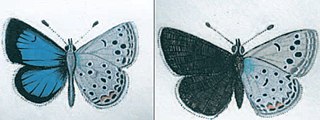
Plumbaginaceae is a family of flowering plants, with a cosmopolitan distribution. The family is sometimes referred to as the leadwort family or the plumbago family.

Acantholimon is a genus of small flowering plants within the plumbago or leadwort family, Plumbaginaceae. They are distributed from southeastern Europe to central Asia and also in South America, but also cultivated elsewhere in rock gardens.
Acantholimon koeycegizicum, is a species of plant belonging to the family Plumbaginaceae.

Caryophyllales is a diverse and heterogeneous order of flowering plants that includes the cacti, carnations, amaranths, ice plants, beets, and many carnivorous plants. Many members are succulent, having fleshy stems or leaves. The betalain pigments are unique in plants of this order and occur in all its families with the exception of Caryophyllaceae and Molluginaceae.

Aegialitis is a genus of two shrubby mangrove species, with one native to Southeast Asia and the other native to Australia and Papua New Guinea.

As of 2000 about 9300 species of vascular plant were known to grow in Turkey. By comparison, Europe as a whole contains only about 24% more species, despite having thirteen times the area.

Lake Nemrut is a freshwater crater lake in Bitlis Province, eastern Turkey. It is part of Nemrut Caldera, a volcanic caldera atop Volcano Nemrut. The caldera is a registered natural monument and the wetland is registered as a Ramsar site of the country.
The wildlife of Turkey is abundant and very varied. Turkey is a large country with many geographic and climatic regions and a great diversity of plants and animals, each suited to its own particular habitat. About 1500 species of vertebrates have been recorded in the country and around 19,000 species of invertebrate. There are about 11,000 species of flowering plants; some of the world's staple crops were first cultivated in this area, and many of their wild relatives are still found here. The country acts as a cross roads with links to Europe, Asia and the Near East, and many birds use the country as a staging post during migration.
Dipchasphecia sertavula is a moth of the family Sesiidae. It is found only in the Sertavul Pass in southern Turkey.
Dipchasphecia kopica is a moth of the family Sesiidae. It is found in north-eastern Turkey.
Acantholimon karamanicum is a species of flowering plant. It grows on calcareous mountain slopes in Ermenek.

Flora of the Venezuelan Guayana is a multivolume flora describing the vascular plants of the Guayana Region of Venezuela, encompassing the three states south of the Orinoco: Amazonas, Bolívar, and Delta Amacuro. Initiated by Julian Alfred Steyermark in the early 1980s, it was completed after his death under the guidance of Paul E. Berry, Kay Yatskievych, and Bruce K. Holst. The nine volumes were published between 1995 and 2005 by Timber Press and Missouri Botanical Garden Press. The project brought together more than 200 botanists from around the world and was "the first effort to produce a comprehensive inventory and identification guide for the plants of such an extensive region of northern South America".

Turanana cytis, the Persian odd-spot blue, is a butterfly of the family Lycaenidae. It was described by Hugo Theodor Christoph in 1877. It is found in the Turkey, the Kopet-Dagh and Iran.

Turanana endymion, the odd-spot blue or Anatolian odd-spot blue, is a butterfly of the family Lycaenidae. It was described by Christian Friedrich Freyer in 1850. It is found in Turkey, Lebanon and Iran. Records from Europe refer to Turanana taygetica.
Turanana taygetica is a butterfly of the family Lycaenidae. It was described by Rebel in 1902. It is found in Greece and Turkey.

The Eastern Anatolian montane steppe is a temperate grasslands, savannas, and shrublands ecoregion. It is located in high plateau of Eastern Anatolia, covering parts of eastern Turkey, Armenia, Azerbaijan, southern Georgia, and northwestern Iran.

Acantholimon libanoticum(Lebanese prickly thrift, غملول لبناني) is a plant in the family Plumbaginaceae first described by Pierre Edmond Boissier. It is native to Western Asia from Turkey to Syria and Lebanon.
Igor Alexandrovitch Lintchevski was a Russian botanist.
Alexander Gilli was an Austrian botanist and pteridologist. He was a pioneer in research on plant communities.
Acantholimon gillii is a species of plant described by Karl Heinz Rechinger and Mogens Engell Köie. Acantholimon gillii is part of the genus Acantholimon and the family Plumbaginaceae. No subspecies are listed in the Catalog of Life.










